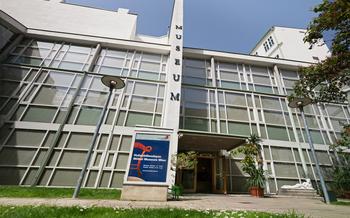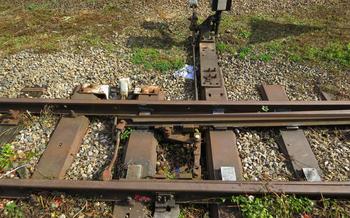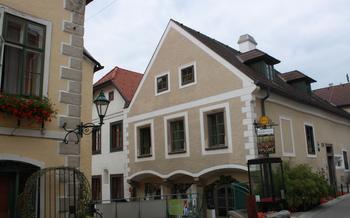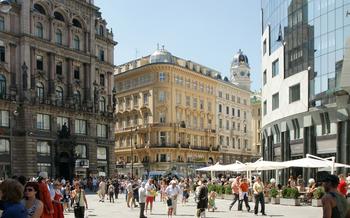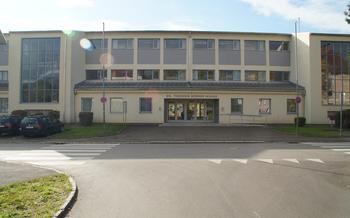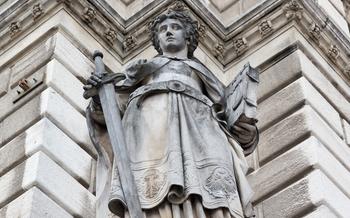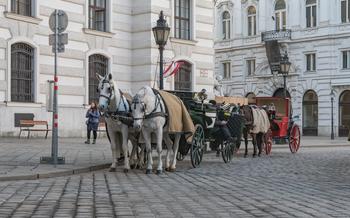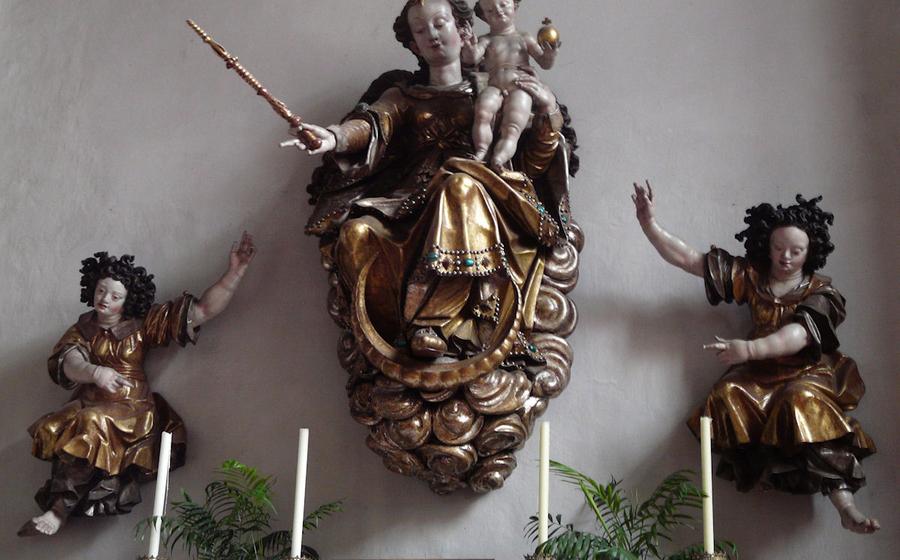
The Spanish Riding School, Vienna
- The Spanish Riding School, Vienna: A Legacy of Elegance
- Witnessing a Performance: Equestrian Perfection
- Exploring the Winter Riding School: Architectural Grandeur
- The Stallburg: A Historic Horse Haven
- Behind-the-Scenes with the Lipizzaners
- The Spanish Riding School Today: Modern Adaptation
- The Elegance of the Lipizzaner Horses
- The Art of Dressage: A Dance of Precision
- The Spanish Riding School as Intangible Cultural Heritage
- Vienna's Cultural Treasures: A Tapestry of History
- Dress Code and Etiquette: Respecting Tradition
- Photography and Capturing Memories
- Souvenirs and Mementos: A Piece of History
- Accessibility and Visitor Information:
- Insider Tip: Unveiling the Secrets of the Spanish Riding School
The Spanish Riding School, Vienna: A Legacy of Elegance
In the heart of Vienna, where history and tradition intertwine, lies the Spanish Riding School, a majestic institution that has captivated audiences for centuries. Established in 1572 during the reign of Emperor Maximilian II, this renowned equestrian academy has dedicated itself to preserving the art of classical dressage and showcasing the grace and elegance of the magnificent Lipizzaner horses. With its intricate training methods, world-class performances, and unwavering commitment to excellence, the Spanish Riding School stands as a testament to the enduring legacy of equestrian artistry.
Throughout its illustrious history, the Spanish Riding School has earned a reputation for unparalleled horsemanship and exceptional training techniques. Its meticulously crafted methods, passed down through generations of master riders, have produced horses of extraordinary skill and obedience. The school's emphasis on harmony and precision has resulted in breathtaking performances that leave audiences in awe.
Witnessing a Performance: Equestrian Perfection
Attending a performance at the Spanish Riding School is an awe-inspiring experience that showcases the extraordinary talents of the Lipizzaner horses and their skilled riders. The most iconic performance is the White Stallion Ballet, a captivating display of dressage artistry set to classical music. The horses, adorned in elegant harnesses and ridden by riders in historical costumes, perform intricate maneuvers with grace and precision. The harmony between horse and rider is truly mesmerizing, creating a breathtaking spectacle that leaves audiences spellbound.
In addition to the White Stallion Ballet, the school also presents the Morning Exercise, a unique opportunity to observe the daily training routine of the Lipizzaner horses. During this session, visitors can witness the horses being put through their paces, demonstrating their obedience, agility, and strength. The Morning Exercise offers an intimate glimpse into the dedication and skill required to maintain the high standards of the Spanish Riding School.
Performances at the Spanish Riding School are held throughout the year, with the season typically running from February to June. To secure tickets for these highly sought-after events, it is advisable to book in advance, especially for the popular White Stallion Ballet. Insider tip: for an unforgettable experience, consider attending a performance during the Summer Nights series, held in the enchanting setting of the Heldenplatz, Vienna's Heldenplatz, against the backdrop of the Imperial Palace.
Exploring the Winter Riding School: Architectural Grandeur
Step into the awe-inspiring Winter Riding School, a masterpiece of Baroque architecture that serves as the majestic stage for the Spanish Riding School's performances. Constructed in the 18th century under the patronage of Emperor Charles VI, this architectural marvel boasts intricate frescoes that adorn its walls and ceilings, a testament to the artistic splendor of the Habsburg era.
Marvel at the breathtaking ceiling mural, a masterpiece created by the renowned artist Johann Michael Rottmayr. This vast and intricate painting depicts scenes from Greek mythology and the history of the Habsburg dynasty, paying homage to the imperial lineage and the equestrian traditions that have flourished within its walls.
Take advantage of the guided tours offered by the Spanish Riding School to delve deeper into the history and significance of the Winter Riding School. Learn about the remarkable feats of engineering that brought this architectural wonder to life, and discover the stories behind the opulent decorations that grace its interior.
Beyond the guided tours, visitors can explore the Winter Riding School at their own pace, immersing themselves in its grandeur and capturing the beauty of its architectural details. Don't miss the opportunity to witness special events and performances held within this magnificent venue, where the harmonious blend of equestrian artistry and architectural splendor creates a truly unforgettable experience.
The Stallburg: A Historic Horse Haven
The Stallburg, located adjacent to the Winter Riding School, holds a significant place in the history of the Spanish Riding School. Originally constructed in the 16th century, it served as the imperial stables for the Habsburg dynasty, housing the prized Lipizzaner horses. The Stallburg's architectural elegance mirrors that of the Winter Riding School, featuring a harmonious blend of Renaissance and Baroque styles.
Inside, visitors can marvel at the well-preserved historical features that evoke the grandeur of the Habsburg era. The vaulted ceilings adorned with intricate frescoes, the ornate horse stalls, and the cobblestone courtyard transport visitors back in time. The Stallburg also houses the Spanish Riding School Museum, which offers a fascinating glimpse into the history of the school and the equestrian arts.
Another highlight of the Stallburg is the Lipizzaner Museum, dedicated to the iconic breed of horses that are synonymous with the Spanish Riding School. Here, visitors can learn about the origins, characteristics, and breeding program of the Lipizzaners. Interactive exhibits and displays provide insights into the unique bond between these horses and their riders.
Guided tours of the Stallburg offer a more in-depth exploration of its history, architecture, and equestrian heritage. Visitors can gain insights into the daily life of the Lipizzaner horses and the behind-the-scenes operations of the Spanish Riding School. Whether self-exploring or joining a guided tour, the Stallburg offers a captivating journey into the world of these magnificent horses and their centuries-old traditions.
Behind-the-Scenes with the Lipizzaners
Beyond the captivating performances, the Spanish Riding School offers a unique opportunity to delve deeper into the world of the Lipizzaners. Visitors can book guided tours that provide an intimate glimpse into the daily lives and care of these majestic horses.
During the tours, visitors can witness the meticulous grooming and training routines that keep the Lipizzaners in peak condition. They can learn about the strict breeding program that ensures the preservation of this rare and noble breed. The tours also shed light on the training methods employed by the school's expert riders, who work tirelessly to establish a deep bond with their equine partners.
These behind-the-scenes experiences offer a profound appreciation for the dedication and artistry that go into creating the performances at the Spanish Riding School. Visitors can marvel at the skill and precision required to execute the intricate dressage movements and witness the harmonious partnership between horse and rider that makes the school's performances so unforgettable.
Whether you're an equestrian enthusiast or simply fascinated by the beauty and grace of these magnificent animals, a behind-the-scenes tour of the Spanish Riding School is an experience that will leave you with lasting memories and a deeper understanding of the world of the Lipizzaners.
The Spanish Riding School Today: Modern Adaptation
The Spanish Riding School has undergone significant evolution over the years, adapting to changing times while preserving its rich traditions. In the past, the school was primarily focused on training horses for military purposes. However, with the advent of modern warfare, the school's focus shifted towards showcasing the beauty and elegance of dressage.
Today, the school continues to uphold its centuries-old traditions while embracing innovation. The training methods have been refined and updated to reflect modern equestrian principles, ensuring the well-being and longevity of the horses. The school also offers educational programs and outreach initiatives to promote the art of dressage and to inspire future generations of riders.
The Spanish Riding School has expanded its reach beyond Vienna, collaborating with other cultural institutions around the world. These collaborations include joint performances, educational exchanges, and cultural events. Through these collaborations, the school shares its knowledge and expertise, contributing to the preservation and promotion of equestrian arts on a global scale.
The Spanish Riding School stands as a testament to the enduring power of tradition and the importance of innovation. By embracing modern approaches while honoring its heritage, the school continues to captivate audiences with its breathtaking performances and serves as a beacon of equestrian excellence for generations to come.
The Elegance of the Lipizzaner Horses
The Spanish Riding School is renowned for its magnificent Lipizzan horses, a breed that originated in the 16th century and is celebrated for its unique characteristics. These horses are known for their distinctive white coat, which they acquire as they mature, transforming from a dark bay or brown color. Their noble demeanor and graceful movements make them a captivating sight, embodying the essence of equine elegance.
The selection process for Lipizzaner horses is rigorous, ensuring that only the finest specimens are chosen. Each horse undergoes a thorough evaluation of its conformation, temperament, and movement. Only those that meet the strict criteria are accepted into the Spanish Riding School's breeding program.
The bond between the riders and their Lipizzaner partners is a crucial aspect of the school's success. The riders dedicate years to training and nurturing this relationship, building a deep understanding and trust with their horses. This connection is evident in the seamless coordination and harmony displayed during performances, where horse and rider move as one.
The Art of Dressage: A Dance of Precision
Dressage, the foundation of the Spanish Riding School's training philosophy, is an intricate and demanding equestrian discipline that emphasizes harmony, precision, and elegance. Rooted in classical principles, dressage involves a series of movements performed by the horse under the guidance of its rider. These movements showcase the horse's obedience, balance, and grace, creating a captivating display of athleticism and artistry.
The Spanish Riding School's dressage training program follows a strict hierarchy of levels, each building upon the previous one. Horses and riders progress through these levels, mastering increasingly complex movements and demonstrating their proficiency in both technical execution and artistic expression. The training process requires patience, dedication, and an unwavering commitment to excellence.
At the heart of dressage lies the concept of harmony between horse and rider. The rider must communicate with the horse through subtle cues, using their seat, hands, and legs to guide the horse's movements. The horse, in turn, must respond with precision and fluidity, mirroring the rider's intentions. This harmonious partnership is essential for achieving the elegance and grace that define dressage.
Dressage competitions provide a platform for riders and horses to showcase their skills and artistry. These events are judged by a panel of experts who evaluate the horse's obedience, accuracy, and overall elegance of movement. The highest level of dressage competition is the Grand Prix, where riders and horses perform a series of intricate movements, demonstrating their mastery of the art.
Witnessing a dressage performance at the Spanish Riding School is a captivating experience. The precision and grace of the horses, combined with the skill and artistry of the riders, create a mesmerizing spectacle that leaves audiences spellbound.
The Spanish Riding School as Intangible Cultural Heritage
The Spanish Riding School holds a significant place in the world's cultural heritage, earning recognition from UNESCO as an Intangible Cultural Heritage. This prestigious designation recognizes the school's exceptional value as a living tradition that embodies centuries of equestrian knowledge, skill, and artistry. The Spanish Riding School represents a unique fusion of classical horsemanship, Baroque architecture, and the enduring legacy of the Habsburg Empire.
The preservation and transmission of the school's traditional equestrian arts are of utmost importance. UNESCO's recognition highlights the need to safeguard this living heritage and ensure its continuity for future generations. The school actively promotes and transmits its knowledge and skills through educational programs, workshops, and international collaborations. By fostering partnerships with other cultural institutions, the Spanish Riding School contributes to the preservation and dissemination of traditional equestrian arts worldwide.
UNESCO's recognition serves as a testament to the global significance of the Spanish Riding School. It underscores the school's role in safeguarding and celebrating the intangible cultural heritage of horsemanship and the equestrian arts. The school's dedication to preserving tradition while embracing innovation ensures that this remarkable legacy continues to thrive and captivate audiences worldwide.
Vienna's Cultural Treasures: A Tapestry of History
The Spanish Riding School is an integral part of Vienna's rich cultural tapestry. Its history and traditions are interwoven with the city's imperial past, making it a symbol of Vienna's cultural heritage. The school's performances and events are not just equestrian spectacles; they are cultural experiences that transport visitors back in time.
Vienna is a city renowned for its cultural treasures. From its magnificent palaces to its world-class museums, the city offers a wealth of artistic and historical attractions. The Spanish Riding School is a unique gem among these treasures, offering a glimpse into the equestrian traditions of the Habsburg Empire.
The school's performances are a highlight of Vienna's cultural calendar, attracting visitors from around the world. The precision and elegance of the Lipizzaner horses, combined with the skill and artistry of the riders, create a captivating spectacle that leaves a lasting impression.
Beyond the Spanish Riding School, Vienna is home to a wealth of other cultural attractions. The city's musical heritage is celebrated at the Vienna State Opera, the Musikverein, and the Konzerthaus, which host world-renowned orchestras and musicians. Art lovers can explore the Kunsthistorisches Museum, the Belvedere Museum, and the Albertina, which house masterpieces from the Renaissance to the modern era.
Vienna's cultural treasures are not limited to its museums and concert halls. The city's streets and squares are filled with architectural wonders, such as the Hofburg Palace, the Schönbrunn Palace, and the St. Stephen's Cathedral. Visitors can also enjoy the city's vibrant café culture, its traditional markets, and its lively nightlife.
A visit to Vienna is a journey through time, where the past and present intertwine to create a unique and unforgettable cultural experience. The Spanish Riding School is just one of the many treasures that make Vienna one of the world's most beloved cultural destinations.
Dress Code and Etiquette: Respecting Tradition
The Spanish Riding School upholds a legacy of elegance and tradition, and appropriate attire is expected during performances. A dress code is in place to show respect for the school, the horses, and the riders.
For gentlemen, formal attire such as a suit and tie or a tuxedo is recommended. Ladies are encouraged to wear a dress, skirt, or pantsuit that is both elegant and respectful. Avoid wearing casual clothing, shorts, or sportswear.
Beyond attire, respectful behavior is essential. Please refrain from talking during performances, as it can be distracting to the horses and riders. Turn off mobile phones and other electronic devices to eliminate distractions.
Applauding at the appropriate moments is customary. Typically, applause is offered after each performance, as well as at the end of the show. This demonstrates your appreciation for the skill and artistry of the riders and horses.
By following these guidelines, you can contribute to the dignified atmosphere of the Spanish Riding School and show your respect for this cherished tradition.
Photography and Capturing Memories
The Spanish Riding School is a visual spectacle that captivates the hearts of visitors. While capturing the elegance of the performances and the beauty of the Lipizzaners through photography is encouraged, there are guidelines in place to ensure that the experience remains enjoyable for all.
Designated photography areas are available within the venue, allowing visitors to take photos without disrupting the performances or the horses. These areas provide optimal angles for capturing the graceful movements and intricate formations of the horses.
To respect the privacy of the horses and riders, it is important to refrain from using flash photography during the performances. Flash can be startling to the horses and can affect their concentration, potentially disrupting the flow of the show.
For the best photographic results, consider using a camera with a good zoom lens to capture close-up shots of the horses and riders. This will allow you to capture the details of their costumes, the expressions on their faces, and the intricate movements of the horses.
After the performance, take advantage of the opportunity to capture candid shots of the horses and riders as they interact with each other and with visitors. These moments provide a glimpse into the bond between horse and rider and offer a more personal perspective of the Spanish Riding School experience.
Souvenirs and Mementos: A Piece of History
At the Spanish Riding School, memories can be cherished and taken home through a delightful collection of souvenirs and mementos. The school's gift shop is a treasure trove of equestrian-themed items, where visitors can find unique keepsakes and gifts that celebrate the legacy and elegance of the Spanish Riding School.
From commemorative items featuring the school's iconic logo to charming figurines of the graceful Lipizzaner horses, there's something for every taste and budget. For those seeking exclusivity, limited-edition collectibles and artwork inspired by the school's rich history are available.
Equestrian enthusiasts will find a haven in the gift shop, with a carefully curated selection of books, DVDs, and accessories showcasing the art of dressage, the history of the Lipizzaner breed, and the behind-the-scenes workings of the Spanish Riding School.
Whether as a cherished memento of a visit or a special gift for loved ones, these souvenirs serve as tangible reminders of the unparalleled artistry and heritage of the Spanish Riding School.
Pro tip: For the ultimate souvenir, consider purchasing a commemorative coin featuring the Spanish Riding School and its iconic Lipizzaner horses.
Accessibility and Visitor Information:
The Spanish Riding School welcomes visitors from all backgrounds and abilities. Accessibility features are in place to ensure that everyone can enjoy the performances and explore the premises. Wheelchair ramps, designated seating areas, and accessible restrooms are available for visitors with disabilities.
Guided tours are offered in various languages to accommodate international guests. These tours provide a deeper insight into the history, traditions, and daily operations of the school. Visitors can learn about the Lipizzaner horses, their training, and the art of dressage. Reservations for guided tours are recommended to secure a spot.
Ticket prices vary depending on the type of performance or event. Advance booking is advisable, especially for popular shows and during peak tourist season. The Spanish Riding School's website offers comprehensive information on ticket prices, schedules, and booking options.
To make the most of your visit, plan your trip carefully. Check the performance schedule in advance and arrive early to avoid crowds. Dress appropriately, following the guidelines provided by the school. Remember to bring a camera to capture the stunning performances and the beauty of the horses.
If you're an equestrian enthusiast or simply seeking a unique cultural experience, the Spanish Riding School is a must-visit. Immerse yourself in the world of classical dressage, marvel at the grace of the Lipizzaner horses, and witness the legacy of elegance that has captivated audiences for centuries.
Insider Tip: Unveiling the Secrets of the Spanish Riding School
Beyond the captivating performances and architectural wonders, the Spanish Riding School holds hidden gems and exclusive opportunities for those seeking a deeper connection with this equestrian haven.
-
Exclusive Events: Indulge in unforgettable experiences like the annual Summer Night Gala, where the Lipizzaners perform under the stars, or the Advent Concert, where the harmonious sounds of classical music fill the Winter Riding School.
-
Behind-the-Scenes Tours: Embark on an immersive journey with a guided tour that takes you behind the scenes, offering a glimpse into the daily lives of the Lipizzaners, their training regime, and the dedication of the riders.
-
Local Recommendations: For a truly authentic experience, venture beyond the Spanish Riding School and explore the vibrant neighborhood of Josefstadt. Discover charming cafes, quaint boutiques, and hidden culinary treasures that reflect Vienna's rich cultural tapestry.
-
Hidden Gems: Uncover the secrets of the school's vast history at the Spanish Riding School Museum, where you'll find a collection of historical artifacts, uniforms, and memorabilia that tell the story of this equestrian institution.

